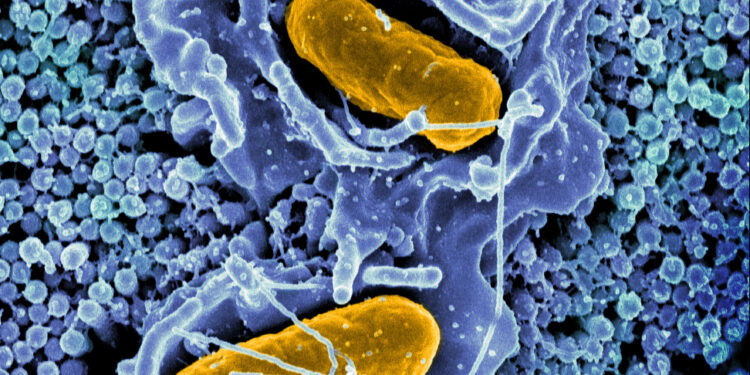Scanning electron micrograph of Salmonella typhimurium invading a human epithelial cell. Credit: Journal of Bacteriology (2023). DOI: 10.1128/jb.00183-23
Salmonella is known to survive and replicate within macrophages, which are normally lethal to invading bacteria due to their inhospitable environment. In a new study, researchers have discovered how a system of proteins, called TamAB, helps Salmonella survive in the harsh conditions of macrophages.
Salmonella is a foodborne pathogen that causes more than a million infections each year in the United States. What is concerning is that it can kill young, elderly and immunocompromised individuals. What makes these bacteria particularly dangerous is their ability to evade our immune responses.
Macrophages are designed to kill bacteria by spraying them with antibacterial products, exposing them to acidic environments, and retaining magnesium, all of which target the bacteria’s outer layers. Salmonella, however, has evolved mechanisms to survive and grow in this environment.
Under normal conditions, Salmonella uses a complex called Bam to assemble certain proteins that are transported to its outer membrane layer. In previous studies, the group showed that inside macrophages the complex is compromised and therefore Salmonella depends on the PhoPQ system to sense the environment and orchestrate the necessary changes in the outer membrane.
Studies in other bacteria have shown that the TamAB complex performs similar functions to Bam, leading the researchers in the current study to wonder whether it might be important in Salmonella. They found that the genes responsible for producing TamAB were controlled by PhoPQ.
“We knew from other studies that TamA was similar to BamA in structure. When we realized that PhoPQ controlled this TamAB complex, we hypothesized that the Bam complex fights in the macrophage and that TamA is induced by PhoPQ to help,” said James Slauch. (IGOH), professor of microbiology.
To test their hypothesis, the researchers first removed TamAB from Salmonella. To their surprise, these mutants were still capable of causing infection in mice. However, when they also crippled the Bam complex, mutants lacking TamAB struggled.
The researchers also saw similar results when they recreated the macrophage-like conditions in test tubes and tested the different Salmonella mutants. They observed that mutants lacking the Bam and TamAB complexes were sensitive to vancomycin.
This result is particularly intriguing because vancomycin is not used to treat salmonella since it cannot cross the outer membrane. This sensitivity suggests that both complexes have a function in creating or maintaining the outer membrane, although the mechanism is unclear.
“Basically, TamAB helps create favorable conditions for the Bam complex to function, but it is indirect,” said Yekaterina Golubeva, a research scientist at the Slauch laboratory.
It is still unclear what the indirect effect might be. “The problem is that studying the outer membrane is complicated because everything is interconnected. If you mess up the Bam complex, it disrupts the additional machinery needed for outer membrane synthesis. As a result, it’s difficult to understand the contributions of these proteins,” Slauch said.
Nevertheless, researchers now want to understand how TamAB helps. To do this, they will use suppressor mutants that have accumulated different types of mutations that can help them grow even if their Bam and Tam complexes are defective, providing insight into the structure and function of Salmonella’s outer membrane.
“There are efforts underway at biotech companies targeting the Bam complex as a way to treat Salmonella infections,” Slauch said. “Understanding the structure of the outer membrane when Salmonella is in a macrophage can help us understand what will affect its sensitivity to drugs and our results with vancomycin point in this direction.”
The study is published in the Journal of Bacteriology.
More information:
Rouhallah Ramezanifard et al, TamAB is regulated by PhoPQ and functions in outer membrane homeostasis during Salmonella pathogenesis, Journal of Bacteriology (2023). DOI: 10.1128/jb.00183-23
Provided by University of Illinois at Urbana-Champaign
Quote: Study discovers how a protein system helps Salmonella survive inside macrophages (January 11, 2024) retrieved January 11, 2024 from
This document is subject to copyright. Apart from fair use for private study or research purposes, no part may be reproduced without written permission. The content is provided for information only.



